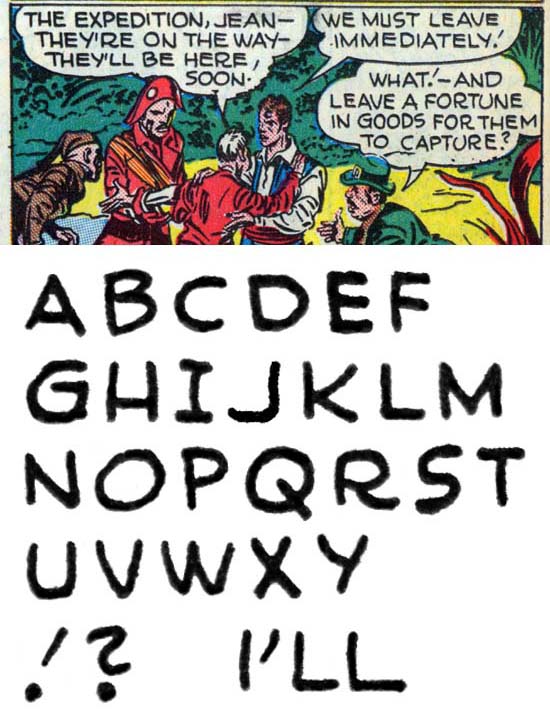
Real Fact #1 (March 1946) “Pirate Or Patriot?” by Ray
The first post-war Simon and Kirby features to be published were possibly done while Jack Kirby was still in the Army and certainly while Joe Simon was in the Coast Guard. I have nick-named the letterer as Ray. Ray used vertical outer strokes for ‘M’ but his most distinguished feature is the curved provided to the diagonal lower stroke for ‘R’. Ray is a bit of an enigma. There was a time I thought Ray might actually be Simon. Both use the same type of ‘M’ and early in his career Joe sometimes used a similar ‘R’. Further Simon’s work on Adventure Is My Career and True Comics showed that he could letter without his classic ‘W’ and in a more professional and careful manner. However Ray would letter some Simon and Kirby work right up to cover date January 1947. This is well beyond Simon and Kirby’s work on Stuntman and Boy Explorers for Harvey that I will discuss below. It is hard to believe that Joe would sacrifice time on lettering better served for the Harvey features. The earliest lettering by Ray appears to be “Coast Guard Reconnaissance” that appeared in Boy Commandos #12 (September 1945). This was certainly done while Joe was still in the Coast Guard and Jack in Europe. Joe was not in a position to find someone new to do the lettering. Perhaps DC had the lettering done. This seems reasonable because Ray would not letter any of Simon and Kirby’s work for Harvey. The only problem with that idea is that Ray lettered “You Can’t Loose A Faithful Dog” from Picture News #1 published, not by DC but by Lafayette Street Corp.
With both Joe Simon and Jack Kirby back in civilian life a deal was made to produce Stuntman and Boy Explorer titles for Harvey. Whether it was a reaction that DC had because of this, or the general changes in comic books that followed the war, DC curtailed the work that Simon and Kirby did for them. Simon and Kirby’s Sandman would end with Adventure Comics #102 (February 1946). The Newsboy Legion would continue in Star Spangled Comics until issue #64 (January 1947). These would be lettered by Ray (#53, #54, #55, #59, #60, #63 and #64), Howard Ferguson (#61 and #62), and another unidentified letter (#56, #57 and #58). The Boy Commandos would last the longest with the last issue being #36 (November 1949). But Simon and Kirby would only provide story art for some of the issues (#15, #17, #19, #21, #23, #24, #29, #30, #31, #32 and #33). Unfortunately I no longer have access to any of these issues. Nor do I have access to Detective Comics #95, #110, #134, #136, #137, #140 and #150 which also had Boy Commando features done by Simon and Kirby. I do have scans for Detective Comics #128 (October 1947) and there the Boy Commandos lettering was done by Ben Oda. That however does not make up for all the DC work I am missing which would have shed light to an interesting aspect of Simon and Kirby history.
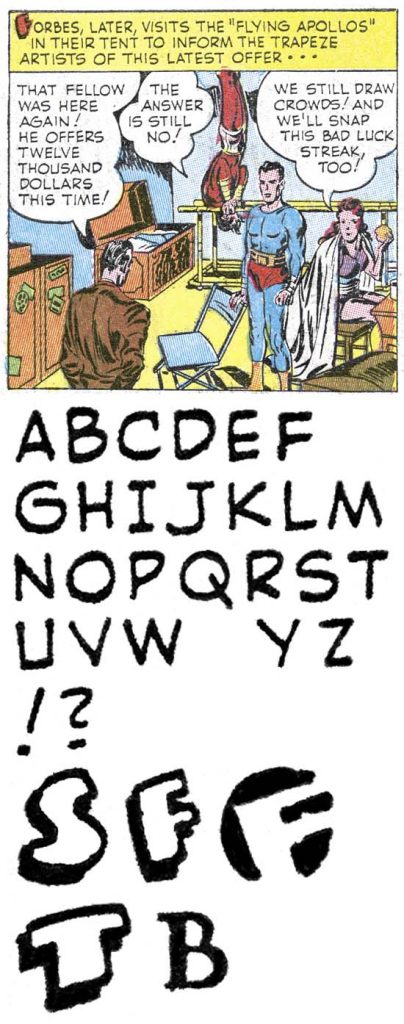
Stuntman Comics #1 (April 1946) “Killer in the Big Top” by Howard Ferguson
Howard Ferguson would return to working for Simon and Kirby for the comic titles Stuntman and Boy Explorers produced for Harvey. His lettering really has not changed much from the work he did for Joe and Jack at DC before they went to do their military service.
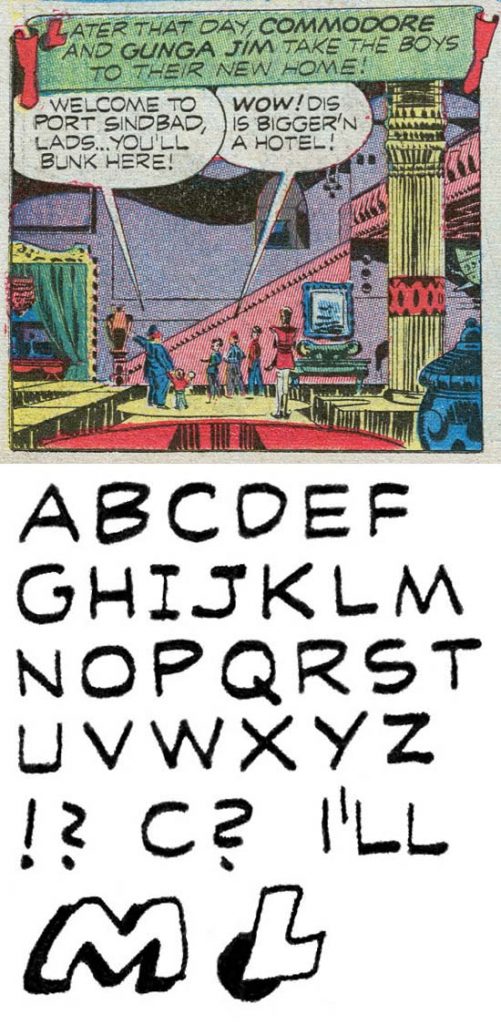
Boy Explorers #1 (May 1946) “Talent for Trouble” by Howard Ferguson
As work on the Harvey features progressed, Ferguson would change his style in one small but important way. In “Talent for Trouble” the serif on ‘C’ would be come smaller and some ‘C’ would lack it altogether.

Stuntman Comics #3 (October 1946) “Rest Home for Criminals” by Howard Ferguson (but the example above is actually from the reprint in Green Hornet #39)
Ferguson’s changing ‘C’ would continue so that only an occasional ‘C’ would exhibit a small serif an example shown above in the second from last line. Stuntman and Boy Explorers would be casualties of the post-war comic glut. However unused work for these titles would continue to appear in Harvey titles such as Green Hornet, Terry and the Pirates, Black Cat and Joe Palooka. But this provides a misleading indication of when Howard Ferguson lettered for Simon and Kirby as it was inventoried work published well after it was actually created.
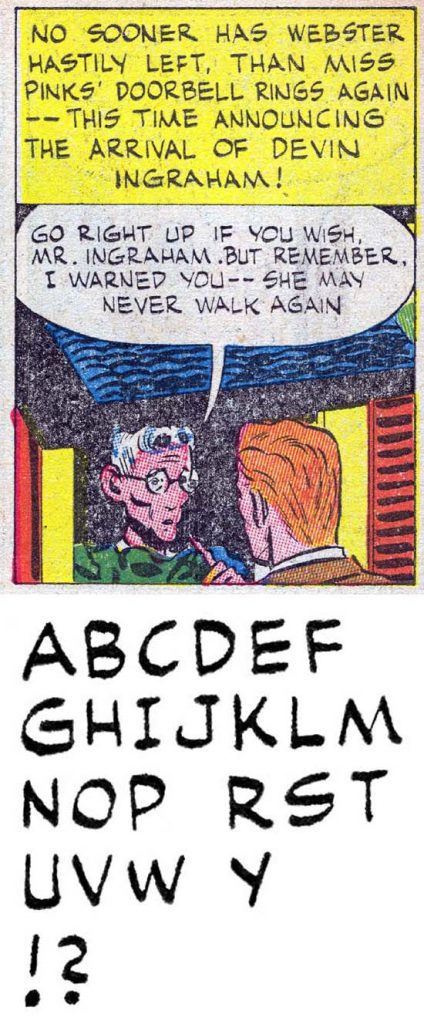
Stuntman Comics #2 (June 1946) “Triangular Troubles” by Bill Draut
As in previous times, Howard Ferguson was the go to guy for lettering the Simon and Kirby Harvey productions done just after the war. Besides Joe and Jack, other artists did art for Simon and Kirby Harvey titles. One was Bill Draut, an artist Joe Simon met while serving in the Coast Guard. All the features that Draut did for the Simon and Kirby’s Harvey titles was lettered by himself. Actually there are a few of exceptions where the splash would be done by others. His ‘S’ has a almost straight and horizontal middle portion. Even more distinctive is the hook shape to his ‘J’. Generally Draut’s ‘J’ will have a small horizontal serif on the top, but sometimes this is left out. Bill’s art and lettering would continue to be found in Harvey’s other titles after Stuntman and Boy Explorers were cancelled. Once again this is inventory work and should not be used to establish dates.
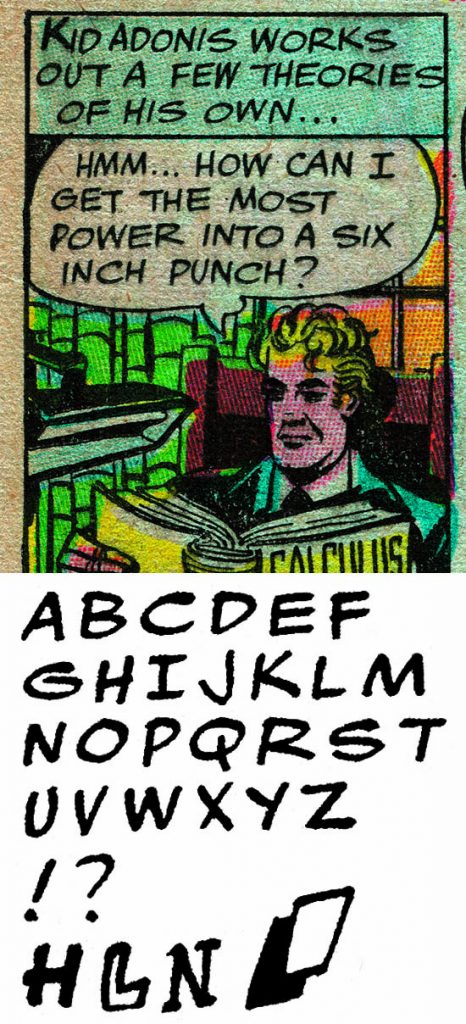
Stuntman Comics #3 (October 1946) “Bust of Adonis” by unidentified letterer (example here from reprint in Green Hornet #37)
There is one other letterer who worked on a single Simon and Kirby’s Harvey feature. Normally I do not include such a letterer here because he only did this one lettering for Joe and Jack. However some of the ‘C’s that he used can appear to have an serif somewhat similar to Ferguson’s (see the text balloon in the image above). But this unidentified individual has a distinctive ‘J’ where the lower portion meets the vertical at an acute angle and his question mark is quite different from that used by Ferguson.
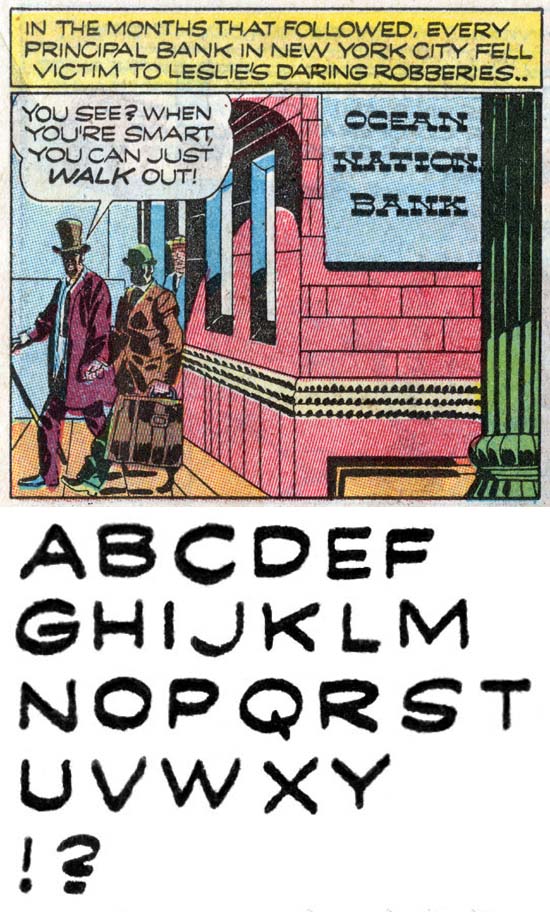
Clue Comics vol. 2 no. 1 (March 1947) “King of the Bank Robbers” by Wyatt
Having soured their relationship with DC by the Harvey deal and then having the Harvey titles cancelled, Simon and Kirby had to search elsewhere for work. Initially they would produce comic book features for Hillman and Prize. One might have expected the lettering for this work would be done by Howard Ferguson but that was not the case. We will return to what happened to Ferguson in a later chapter but for now the lettering would be done by others we have not previously encountered. The first published post-Harvey work would be cover dated March 1947 and all but one of the eight features that included would be done by one letterer, nick-named Wyatt. I have not found any previous lettering by Wyatt in \neither comics by Hillman or Prize. Wyatt’s lettering is very professional; clear letters with good and even line spacing. He can easily be distinguished from either Howard Ferguson or Ben Oda by his ‘M’ with vertical outer strokes and his ‘Y’ with a vertical lower branch. In his earlier lettering the top of ‘J’ lacks a serif.
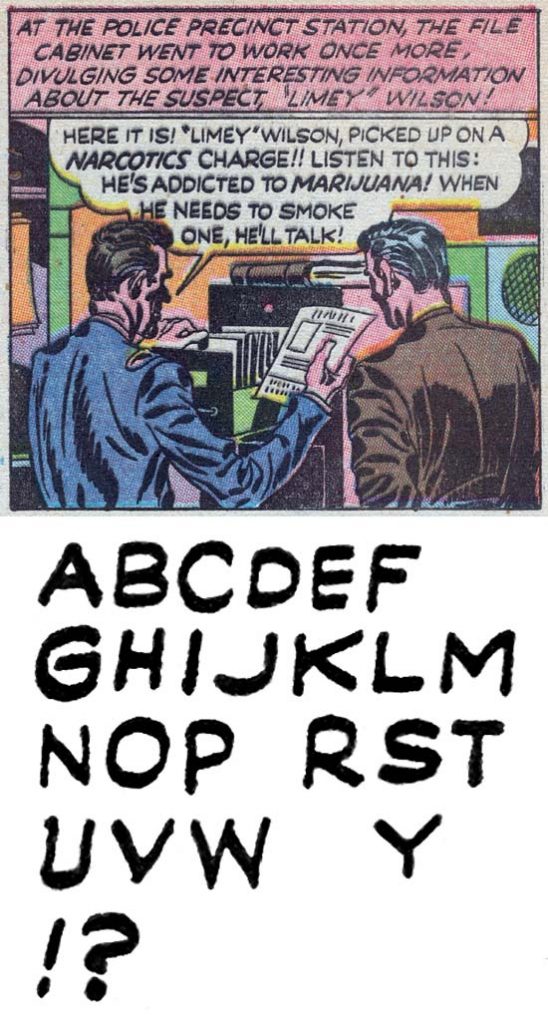
Headline Comics #24 (May 1947) “Trapping New England’s Chain Murderer” by Wyatt
While the previous example showed standard lettering in the captions, in all other lettering by Wyatt he used italics in the captions. Bold lettering would also be italicized but that was pretty common. Unlike Ferguson, Wyatt does not use drop caps or banners in his captions to panel art. Wyatt would also do all the lettering for Headline #24 (May 1947) but his other work for Simon and Kirby would be more sporadic.
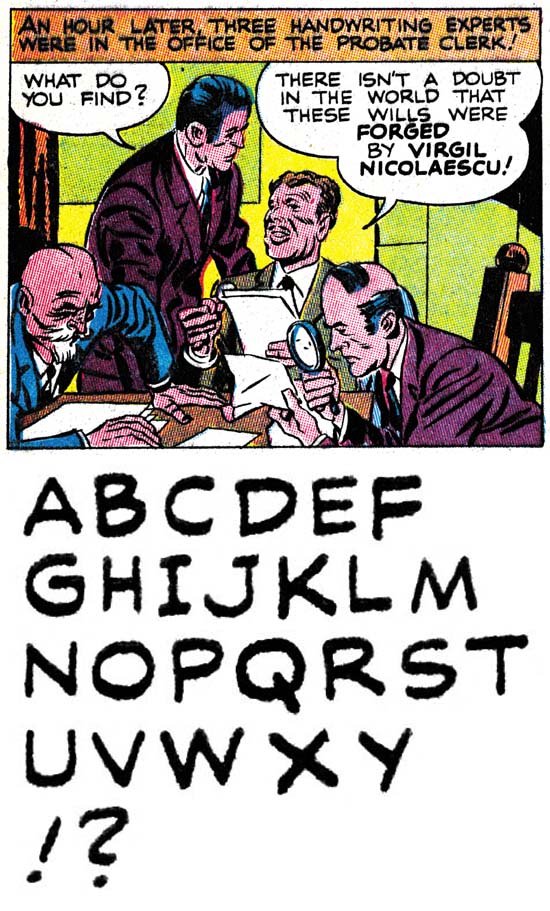
Prize Comics #63 (March 1947) “Romania’s Strangest Killer” by Ben Oda?
The one initial feature from post-Harvey that was not done by Wyatt was questionably lettered by Ben Oda. Like Wyatt I have not been able to find any previous lettering by Oda in either Hillman or Prize comics. As previously mentioned, Oda can easily be distinguished from Wyatt by the letters ‘M’ and ‘Y’. However Oda’s letters are very similar to those by Howard Ferguson. Unlike Ferguson, Ben did not use drop caps or banners in the panel art for Simon and Kirby productions. Oda used italics only for bold lettering and not in captions like Wyatt. The only reason I question that Oda lettered “Romania’s Strangest Killer” is that there is a small serif on the top of the ‘J’s while typically Ben’s ‘J’ lack such a serif.
Golden age comics rarely include credits and I have never seen any for Ben Oda. Therefore one might reasonably wonder why this and others lettering I will be discussing should not be credited to Ferguson. The answer is that I had to work backwards from a period where I am confident that the lettering was done by Oda. Why I am confident in this will be discussed when I reach that time period. What I can say for now is that Ben’s lettering for Simon and Kirby can be traced with numerous examples from this point on. While Oda’s lettering does change over time the changes are small and gradual. And they reach a point where Oda can be compared to Ferguson’s work at the same dates and while close, they can be distinguished.
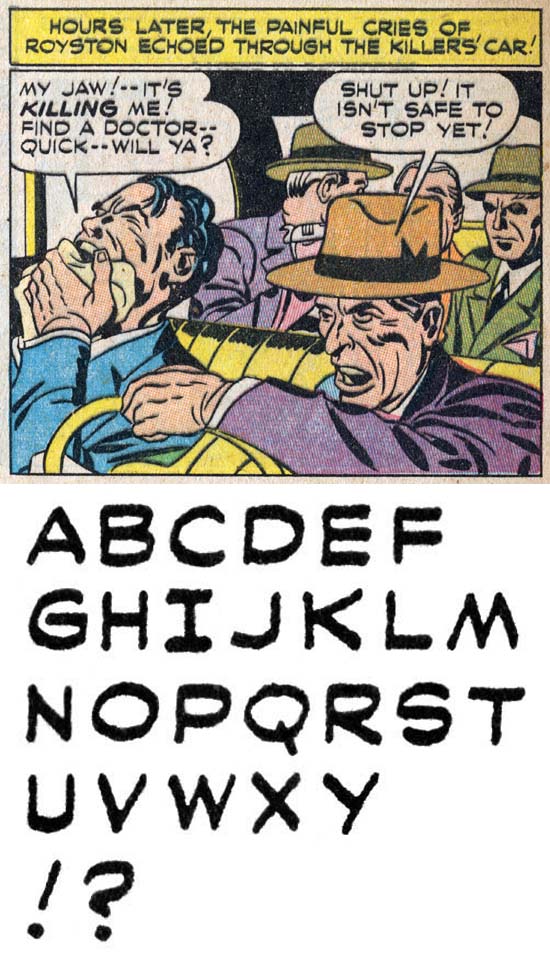
Clue Comics vol. 2 no. 3 (May 1947) “The Case of the Superstitious Slayers” by Ben Oda
Because my previous Ben Oda example was questionable, I thought I would provide an early lettering that I am more confidently attribute to him. While Wyatt would be used a lot for Simon and Kirby’s initial post-Harvey lettering, as time went on Ben Oda would be used more frequently until he would dominate.
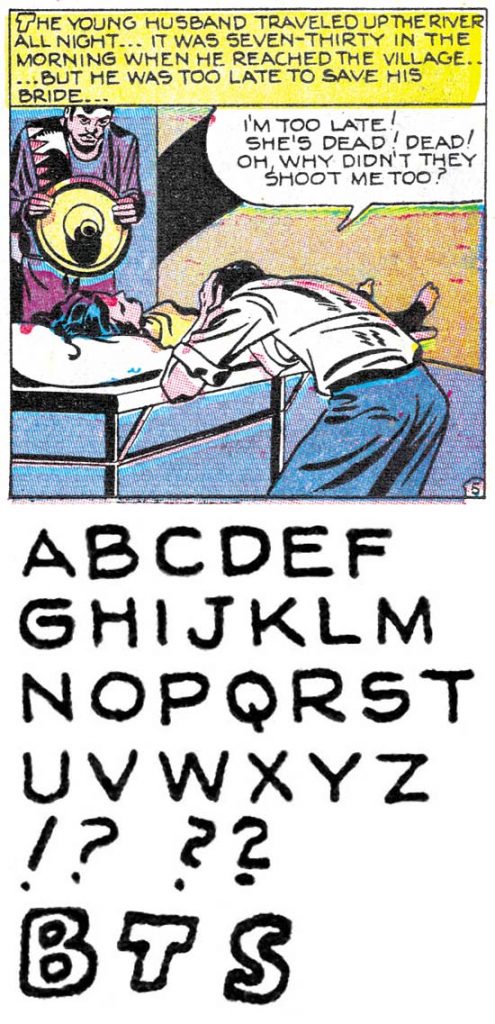
Headline Comics #25 (July 1947) “Death Takes a Honeymoon” by Fred
Headline Comics #25 (July 1947) had seven features, four of which were lettered by yet another letterer I call Fred. Fred’s ‘M’ and ‘Y’ have the same form used by Wyatt but Fred’s question marks are quite different from Fred’s. Further captions by Fred use standard lettering unlike the italics that Wyatt preferred (except for one early work). Fred had captions that included outline drop caps, a feature not used by Wyatt.
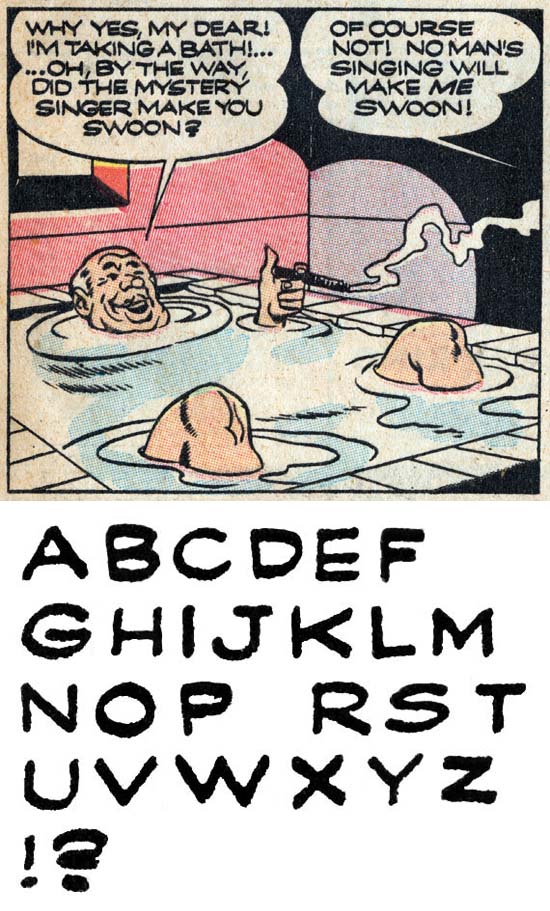
Punch & Judy Comics vol. 2 no. 12 (August 1947) “The Mystery Crooner” by Wyatt
I want to close this chapter with one final example by Wyatt. Wyatt’s lettering had not change much over the time being discussed here, not surprising because it is only a mater of five months. But the question mark has become like a squat ‘2’.
Simon and Kirby was about to introduce a new comic book title for Prize after which their work for Hillman would dwindle to end shortly later.
Lettering S&K Chapter 1 The Beginning
Lettering S&K Chapter 2 Timely, DC and the War
Lettering S&K Chapter 4 The Oda Monopoly
Lettering S&K Chapter 5 Mainline and the Studio End
Lettering S&K Chapter 6 Post Studio
Lettering S&K Chapter 7 Conclusion
Lettering Checklists:
Alias
Draut, Bill
Ferguson, Howard
Kirby, Jack
Oda, Ben
Simon, Joe


Pingback: Lettering S&K Chapter 1 The Beginning | Simon and Kirby
Pingback: Lettering S&K Chapter 2 Timely, DC and the War | Simon and Kirby
Pingback: Lettering S&K Chapter 4 The Oda Monopoly | Simon and Kirby